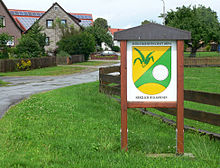Düna (Osterode am Harz)
|
Daugava
City of Osterode am Harz
Coordinates: 51 ° 41 ′ 20 ″ N , 10 ° 17 ′ 1 ″ E
|
||
|---|---|---|
| Height : | 275 m above sea level NN | |
| Residents : | 126 (Jul 1, 2012) | |
| Postal code : | 37520 | |
| Area code : | 05522 | |
|
Location of Düna in Lower Saxony |
||
Düna is a village in the southwestern Harz foreland and district of the city of Osterode am Harz in the district of Göttingen in southern Lower Saxony , Germany . In 2012 Daugava had 126 inhabitants.
history
The area of today's Düna has been settled since the fourth century AD. Settlement began south of the domain as early as the first century BC. The smelting of Iberger and Lerbacher iron ores has been proven during this period . Since approx. 300 AD silver has been extracted from Upper Harz ores and copper from Rammelsberg ores. This was the result of an excavation of the Institute for the Preservation of Monuments that began in 1981 with the discovery of the Düna manor . It has been found that furnaces for smelting iron ore originated in the Middle Ages.
The first written mention of Düna was in 1286 as Dunede. The settlement is mentioned in a deed of donation from some ministerial officials who bequeathed some Hufen land and bailiwick rights to a chapel in Düna to the Jacobi monastery in Osterode . It is no longer known where this chapel was located. Later, Düna is mentioned in documents in 1329, 1336 and 1372, whereby it was designated as Vorwerk Dunde in 1372 . Düna was on a medieval long-distance trade route to the south to what was then an important traffic junction, which also included the Palatinate Pöhlde and the Wallburg Pöhlde . At the end of the 14th century the settlement fell into desolation and was repopulated in the first half of the 16th century when a domain for the sovereign estates was created. During this time there was a brickworks below the domain, which produced until 1914. In the 17th century there were 17 people living on the domain and in the brickworks; in 1852 there were 28 residents. In the early 1930s, the Hannoversche Siedlungsgesellschaft acquired the estate and divided it into 22 farms in 1935. The architect Franz Josef Jirka designed a new settlement under the name "Harzer Neubauersiedlung" Düna.
In 1972 Düna, which until then had belonged to the municipality of Hörden as a residential area , was incorporated into the city of Osterode am Harz.
nature
The nature reserve Hainholz Gypsum Karst Landscape is located near Düna , in which a large number of gypsum karst formations can be seen spatially close together .
politics
Due to its small number of inhabitants, Düna is a village with a mayor and therefore does not form its own local council.
Web links
- The history of Duna began in the Stone Age at karstwanderweg.de
Individual evidence
- ↑ a b c d Düna on the website of the city of Osterode am Harz , accessed on February 16, 2017.
- ↑ The history of Duna began in the Stone Age. karstwanderweg.de, accessed on August 20, 2011 .
- ↑ Erhard Kühlhorn: The medieval desolations in southern Lower Saxony Volume 1. AE, Publishing House for Regional History, Bielefeld 1994, ISBN 3-89534-131-2 , pp. 429-431
- ↑ Nature reserve "Gipskarstlandschaft Hainholz". Lower Saxony State Agency for Water Management, Coastal Protection and Nature Conservation, accessed on November 10, 2010 .
- ↑ Description of the nature reserve on the Karst hiking trail pages , accessed on April 12, 2010
- ↑ Main statutes of the city of Osterode am Harz - page 2. Accessed on February 16, 2017 .


